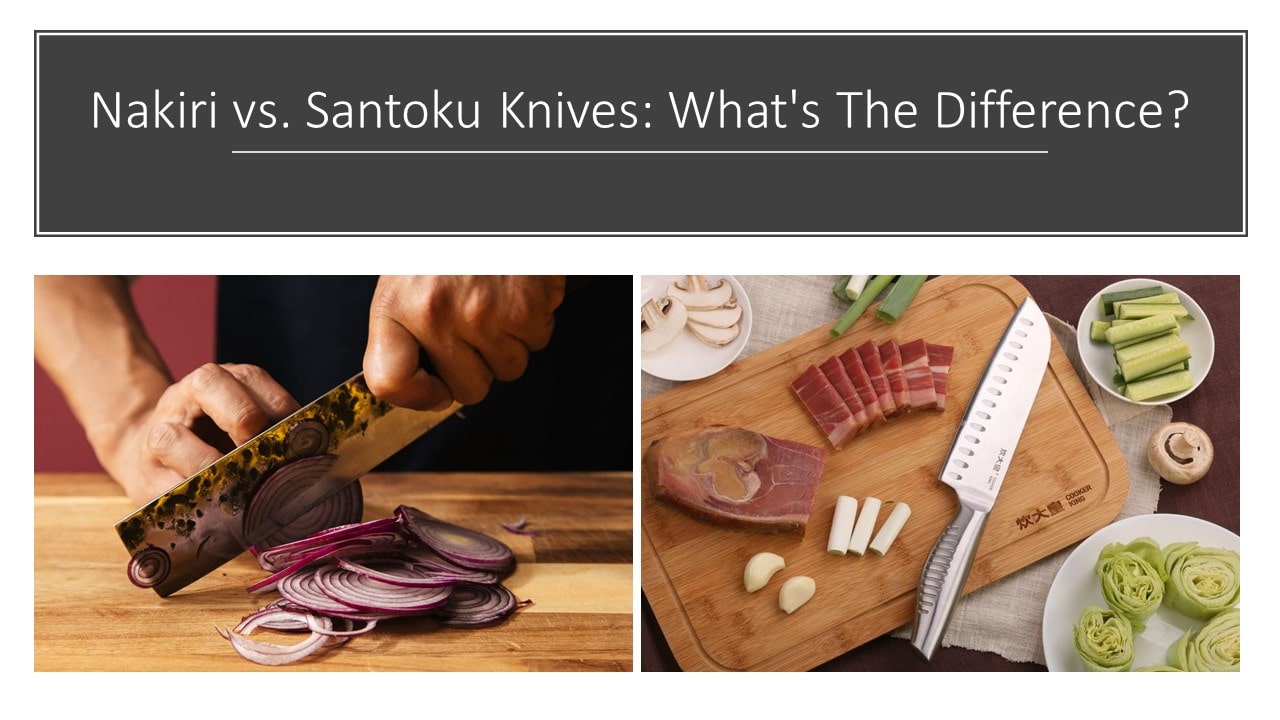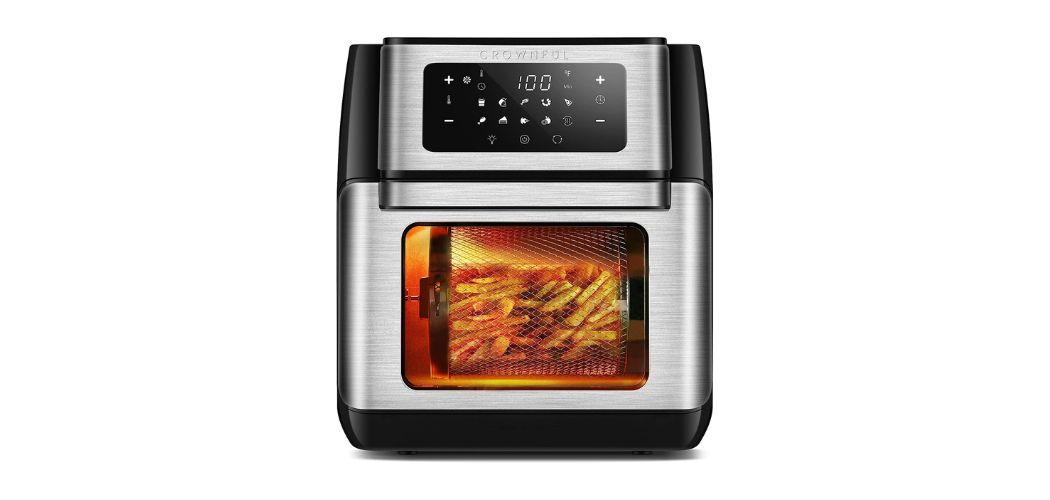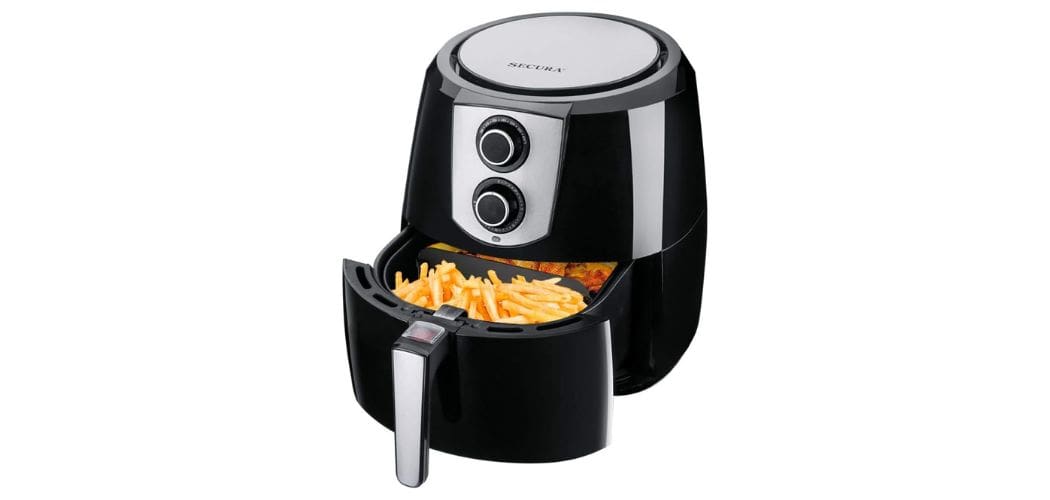Japanese cuisine is becoming more popular since many people find the flavours and dishes quite enticing.
Furthermore, this inclination towards Japanese cuisine is encouraging people to use Japanese kitchen tools to make these delicious dishes.
The types of knives are a significant part of Japanese culinary culture, and as an independent cuisine, the blades differ from Western-style knives.
The Nakiri and Santoku knives are two knives many individuals engage in while looking for Japanese kitchenware.
Both are excellent additions to any home, but which is the better choice? Which blade would suit your cooking needs? Read on to know more about the two knives and see how they fit your meal preparations.
Table of Contents
What Is A Nakiri?
A Grand Swordsmith in Japan created the Nakiri knife in the seventeenth century. He used a standard foldable knife for his everyday activities, such as chopping fruit and vegetables. But he desired a blade that would suit him better.
As a result, he invented a straight side knife with squared ends to make slicing vegetables and fruits simpler. Many artisans seeing him started to design Nakiri knives that were best suited for everyday usage.
In Japanese, Nakiri means “leaf scissors” and relates to the blade’s operation.
Chefs who slice vegetables, melons, and other items for cooking generally use a Nakiri knife.
It features a sharp edge with rectangular tips that aid in vegetable cutting.
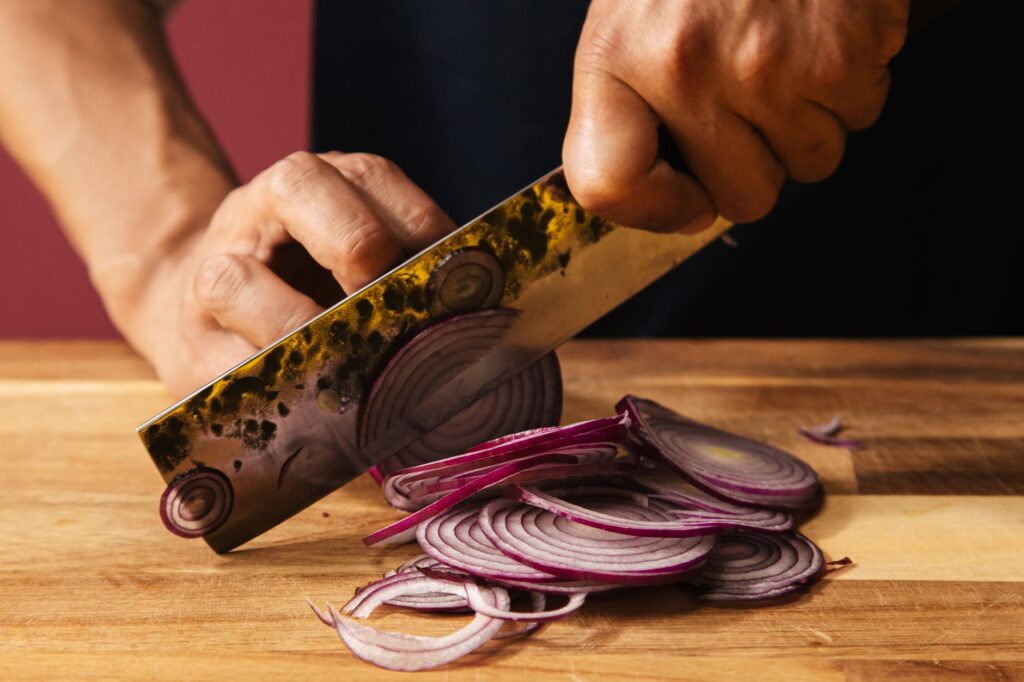
When chopping fresh fruits and vegetables, the straight blade also helps the user to have a more significant influence over the knife. Although it’s created for handling big slices of meat, the Chinese Cleaver is most comparable to the Nakiri.
Since it has a broader blade, it is less accurate when cutting tiny, delicate components. Since Chinese cleavers are bulkier than Nakiri knives, they are more challenging to handle.
The usuba is another knife that is often confused with the Nakiri. The knife design and edge sharpness are the most significant distinctions.
Usuba knives, like Nakiri knives, feature a flat edge and a curved spine, similar to Santoku knives. They also feature a single-bevel, which means they’re sharpened on just one side, making them more suited to skilled or professional chefs.
Benefits:
When you need to carefully and precisely chop vegetables, the main benefit of utilising a Nakiri knife comes into play.
A Nakiri’s flat edge enables even peeling of vegetables for ornamental reasons, but a Santoku does not permit this degree of symmetry.
Another benefit of utilising a Nakiri is the speed and precision it can chop vegetables. When dealing with various veggies, the blade’s sharpness facilitates up and downstream chopping. It is quicker and more precise.
The Nakiri is especially popular among professional chefs due to its tall blade, enabling users to scrape items off the cutting board with the knife’s back, preserving the blade edge.
However, using the side of a Japanese blade to scrape food off a chopping board would rapidly dull the knife, which is why expert chefs prefer to use the spine of a Nakiri.
What Is A Santoku Knife?
Most people often confuse Nakiri and Santoku. A Santoku, which roughly translates to “three virtues,” is a Japanese all-purpose cooking knife used for cutting, chopping, and slicing vegetables, seafood, and livestock.
It features a whole flat honed knife with a sheep’s foot bend on the back.
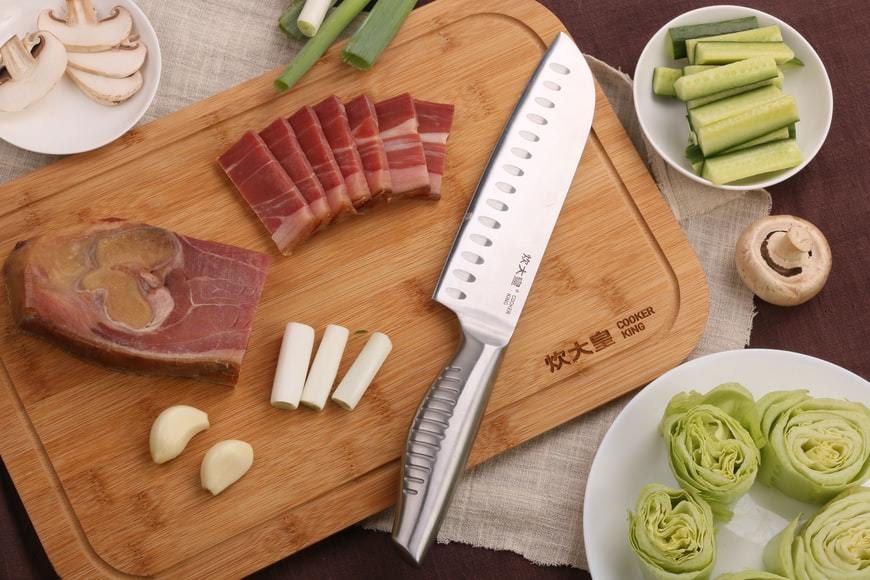
Santoku knives are available in various lengths, ranging from 6 to 8 inches. The height of the blade changes by personal preference and cooking needs.
You may choose a shorter length if you need to use this knife for cutting and slicing, but you can go for more extended versions if you want to carve meats or fish.
Benefits:
The apparent benefit of utilising a Santoku knife is its flexible and multipurpose blade that can handle the bulk of your cutting needs.
The knife’s adaptability is one of the main reasons it became the most famous knife in Japanese households and is gaining favour in Western countries.
Santoku knives’ edges bend to a 10 – 15 degree inclination on both sides of a blade, making it 20 – 30 degrees.
This knife’s razor-sharp edge, typically coupled with a Granton edge, enables it to cut through a range of foods neatly and quickly. Even a culinary beginner can produce superb cuts with a Santoku.
Differences Between A Nakiri And Santoku Knife:
Usage:
To comprehend the contemporary use of Nakiri knives, you must first go back in history and understand the initial use of this cutting tool. The Japanese invented this knife type during the Edo period.
In Japan, four-legged creatures were not lawful food at the time. Therefore, vegetables were their primary dietary source. During that period, knives only cut vegetables. Its solitary purpose as a vegetable cutter came down through the centuries and has stayed the same.
The latter, on the extreme, is capable of more cutting jobs than merely chopping veggies. The Santoku knife originated in the late 1940s, a decade after its competition.
People prepared each dish with a specific knife, and the process got more sophisticated over time. The Japanese created Santoku knives in response to their demand for a more versatile cutting tool.
It can handle a variety of dishes because of its design, which is quite similar to that of ordinary contemporary knives. You can trust these blades with delicate items and rigid materials like meat, seafood, and hard cheese.
Blade Design:
Nakiri’s blade for chopping vegetables has a rectangular form. You can notice it at first glance. It has a rounded tip and a straight, uniform edge. It’s a design tuned for forming the most consistent, pencil-thin slices possible.
You can’t just go wrong with this one when slicing tomatoes, carrots, and other vegetables.
Furthermore, the straight edge tends to make complete contact with the chopping board’s surface, enabling you to create cleaner slices without exerting additional hand pressure.
When mincing onions or jalapenos, using this knife type will ensure that they do not cling together.
The Santoku has a downward bent spine. Its border and spine connect in a sharp, acute point rather than a rounded one.
They are usually thicker than Nakiris. Santoku knives are excellent at handling meals with comparable textures due to the blade shape.
Chopping Motion:
The Nakiri, with its straight and flat side, works for a consistent up-and-down chopping action.
You push the blade directly down in one crisp vertical cut to slice through the veggies or fruit.
Since some individuals use regular knives, they prefer to push and pull the blade rather than make up-and-down cuts.
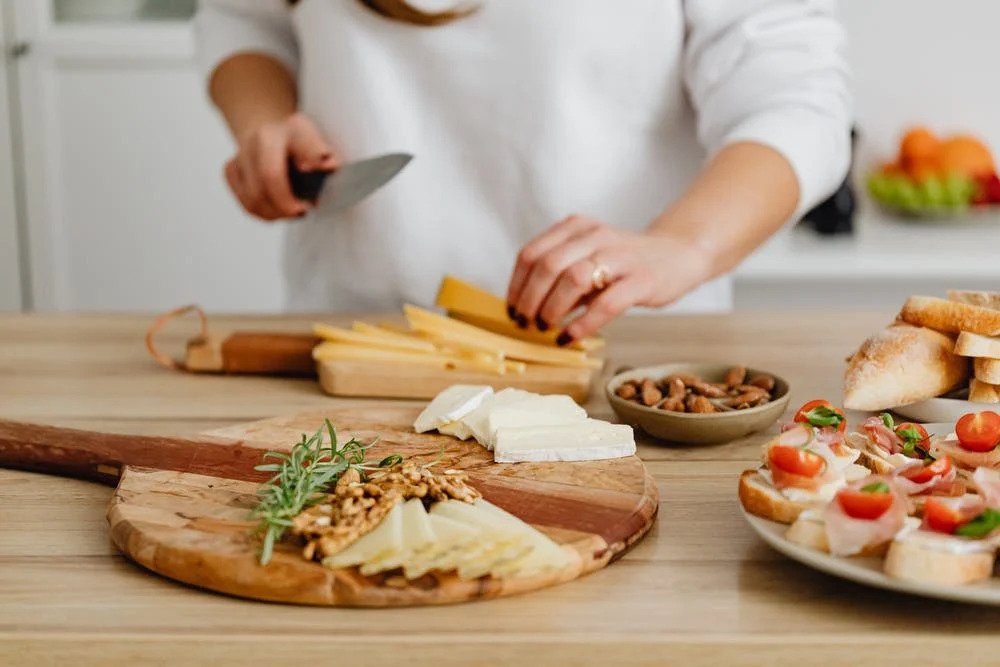
However, it will take more time and will not provide excellent results.
In contrast to the previous, the Santoku knives’ delicate curves complement the vertical cutting method admirably. You may conduct a rock chop by applying more forceful downward pressure.
Vertical chopping also requires largely push-down actions rather than horizontal chopping. There’s no need to drag the blade over the surface of the meat. When slicing the flesh, you must press the knife down and let it do the work.
Size:
There isn’t a significant difference in length between the two knives. It’s primarily because it has little effect on the knife’s cutting ability.
Both blades have undergone several changes to meet the current style, starting with the initial model. Rather than the knife model, the size typically relies on the manufacturer.
Regardless, multifunctional knives are often made with a longer length. A typical model will be between five and seven inches in length.
You’ll have more blade surface to deal with a massive lump of meat or a lengthy fish if you add a few inches to your blade length.
Nakiri knives are usually approximately five inches long, although they may be up to an inch longer than Santoku. Since their only purpose is to chop veggies, they’re designed to be shorter.
Sharpness:
The sharpness of a knife is typically referred to as “the blade angle.” It is the most crucial aspect in determining the cutting effectiveness of a knife. You should also examine the sharpness of the two knives when comparing them.
You can notice the “Ryoba edge,” which hones on both ends of the blade on Nakiris. Each side curves at a 15-degree inclination to provide maximum sharpness.
The manufacturer chose this particular angle from the start, and it has proven to be the ideal angle for producing the thinnest, most equal vegetable slices.
In Santoku knives, you may choose between the Ryoba-edge model and the Kataba-edge type. Only one side of the Kataba edge is usually honed.
The angle of the Ryoba variant is ten to fifteen degrees, whereas the Kataba version is thirty degrees. Because the second has so many applications, there is no set inclination for all knives.
Substantial Kataba knives have less than 10 degrees blade slopes, requiring some practice before usage. As a result, the blade angle is heavily influenced by the function of the knives.
Weight:
The weight of the knives has a significant impact on how easy they are to use. Since the grip material is lighter and the blades are narrower, both are substantially lighter than ordinary kitchen knives.
When examining the two, the vegetable knives are heavier, which may be understood by the cutting motion of each.
Just like gyuto knives, chopping vegetables with traditional Nakiri knives requires steady up-and-down motions; the added weight provides a more significant effect as the blade descends the material.
The lightness of the Santoku allows them to be more agile and versatile while working with various food kinds, owing to their multipurpose nature.
Quick Comparison Guide:
| Aspect | Nakiri | Santoku |
| Usage | Used only for chopping vegetables and lighter foods | It is an all-purpose knife. Used to cut vegetables and meat |
| Blade Design | It has a rectangular form | It has a curved and bent shape |
| Chopping Motion | Up-down chopping motion | Slicing and dicing motion |
| Size | The blade is up to five inches long | It is smaller than Nakiris |
| Sharpness | It has a Ryoba edge model | It has a Ryoba and Kataba edge |
| Weight | They are heavier | These are lighter |
FAQs
How Do You Use A Nakiri Or Santoku To Cut Safely?
While cutting, be sure your chopping board does not shift. Put a small cloth beneath your board to keep it secure.
If you’re learning a new cutting method, take your time and practice at a suitable pace. Never store the knife in a cabinet with other tools, mainly if the blade is held up.
Can A Nakiri Replace Cleaver?
Nakiri is very different from a cleaver. It is used in Japanese cooking to finely slice vegetables and produce textures that are impossible to achieve with a French chef knife. This knife’s edge is often short and broad, similar to an usuba or Santoku blade.
How To Grab A Nakiri?
You must hold a Nakiri in the same manner as a standard kitchen knife. The advantage of Nakiris is that their bent blade allows them to swing back and forth on food rather than slicing through them as other blades. They’re ideal for cutting little bits of onion or shredding ginger because of this.
The Final Verdict:
Is it necessary to have both knives in your kitchen? The quick answer is no. You may use Santoku blades for a variety of tasks. A double-edged Santoku knife can do all of the functions of a Nakiri, plus a lot more.
A Nakiri knife is a speciality knife that excels at one task: cutting vegetables and fruit. The Nakiri’s key benefits are speed and homogeneity. You can rapidly chop vegetables with their flat side and square blade; you don’t need to move the knife to finish each cut.
You also obtain clean, consistent cuts every time since the flat edge makes a full impact with the chopping board.
If you’re a vegan or vegetarian, a Nakiri might be a valuable addition to a more extensive set that comprises a Santoku or chef’s knife.
If you want an all-purpose blade with a little more skill than a chef’s knife, a Santoku is a way to go. Buy a Nakiri if you’re going to add a knife to your collection mainly made for chopping vegetables!

